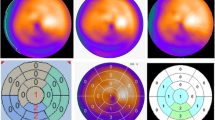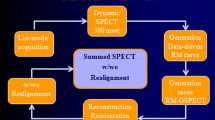Abstract
For children, cardiac nuclear medicine imaging has not been widely used because of problems of physical motion, even in schoolchildren who require no sedation. In this study, rest–stress myocardial perfusion imaging (MPI) with technetium-99m-tetrofosmin (Tc-99m TF) was performed with the use of a Vac-Loc cushion, a patient immobilizer commonly used for radiotherapy, for immobilizing school-age patients. The immobilizer attenuated the gamma radiation by 6%. By visual assessment, physical motion-related artifacts were markedly improved in images acquired with the immobilizer, compared to those without. In the assessment of image reproducibility with the immobilizer, taking the reproducibility as 2.5Σ + 0.7σ, there were deviations of 4.45, 5.28, and 3.28 mm along the X-, Y-, and Z-axes, respectively, demonstrating a high reproducibility and a negligible rest–stress position error. It is suggested that for radiotherapy, the immobilizer could expand the versatility of MPI while allowing only minimal physical motion in children.



Similar content being viewed by others
References
Mandell GA, Majd M, Shalaby-Rana EI, Gordon I. Society of nuclear medicine procedure guideline for pediatric sedation in nuclear medicine. 2003;version 3, p. 174.
Veitch TA. Pediatric nuclear medicine, Part II: Common procedure and considerations. J Nucl Med Technol. 2000;28:69–75.
Gary JRC, Maisey MN, Britton KE, Chengazi V. Clinical nuclear medicine, 4 edn. p. 110.
Charron M. Pediatric PET imaging, Chap. 9, p 128. New York: Springer Science Business Media, Inc.
Monzen H, Hara M, Hirata M, Nakanishi A, Ogasawara M, Suzuki T, Sato T, Shimoyama H, Tadehara F, Hirose K, Yuki R. Exploring a technique for reducing the influence of scattered rays from surrounding organs to the heart during myocardial perfusion scintigraphy with technetium-99m sestamibi and technetium-99m tetrofosmin. Ann Nucl Med. 2006;10:705–10.
Kubo A. Phase I clinical trial of a new myocardial imaging agent, 99mTc-PPN1011. Jpn J Nucl Med. 1992;29(10):1165–76.
van Herk M, Remeijer P, Rasch C. The probability of correct target dosage: dose–population histograms for deriving treatment margins in radiotherapy. Int J Radiot Oncol Biol Phys. 2000;47(4):1121–35.
Monzen H, Hara M, Hirata M, Nakanishi A, Ogasawara M, Suzuki T, Higuchi H, Kobayashi H, Yuki R, Hirose K. New protocol of myocardial SPECT imaging using technetium-99m sestamibi for reducing time interval between rest and adenosine stress phases. Radiol Phys Technol. 2009;1:70–6.
Tadehara F, Yamamoto H, Tsujiyama S, Hinoi T, Matsuo S, Matsumoto N, Sato Y, Kohno N. Feasibility of a rapid protocol of 1-day single-isotope rest/adenosine stress Tc-99m sestamibi ECG-gated myocardial perfusion imaging. J Nucl Cardiol. 2008;15(1):35–41.
Masuda Y, Nagaki A, Kawabuchi Y, Ohya N, Katafuchi T, Teraoka S. Point of acquisition, processing, display and output for standardized images with clinical usefulness. Jpn J Nucl Med Technol. 2008;28:13–66.
Karasawa K. Practice of pediatric nuclear cardiology. Jpn J Nucl Med Technol. 2008;24(1):51–9.
Nakano Y, Fujibuchi T, Isobe T, Uchida Y, Kazama T, Hamada K, Kikawa T, Ito H. Assessment of whole body PET/MRI fusion imaging using automated software: usefulness of partial body fusion. Nippon Hoshasen Gijutsu Gakkai Zasshi. 2006;62(6):822–31.
Author information
Authors and Affiliations
Corresponding author
About this article
Cite this article
Monzen, H., Ban, Y., Hirata, M. et al. Countermeasures against physical motion in schoolchildren requiring no sedation during rest and stress myocardial perfusion imaging with technetium-99m-tetrofosmin. Radiol Phys Technol 4, 19–23 (2011). https://doi.org/10.1007/s12194-010-0100-3
Received:
Revised:
Accepted:
Published:
Issue Date:
DOI: https://doi.org/10.1007/s12194-010-0100-3




